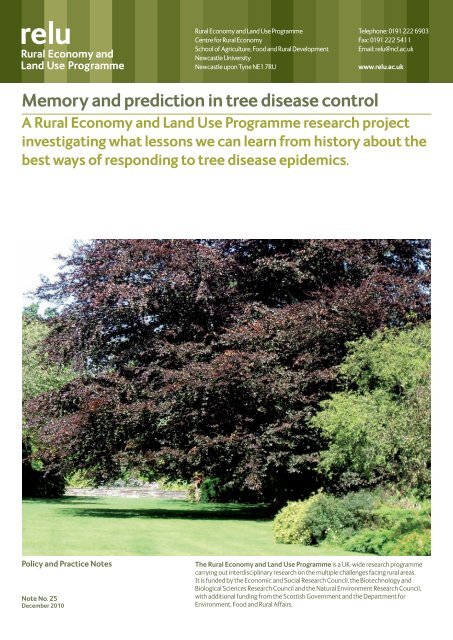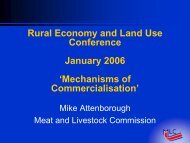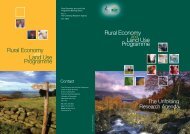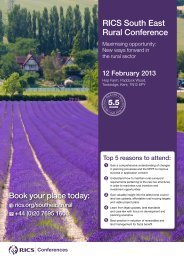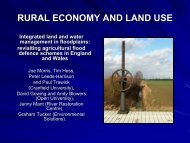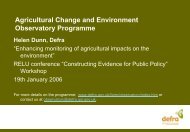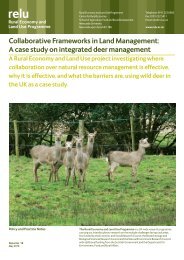Policy and Practice Note no 25. - Rural Economy and Land Use ...
Policy and Practice Note no 25. - Rural Economy and Land Use ...
Policy and Practice Note no 25. - Rural Economy and Land Use ...
You also want an ePaper? Increase the reach of your titles
YUMPU automatically turns print PDFs into web optimized ePapers that Google loves.
<strong>Rural</strong> Eco<strong>no</strong>my <strong>and</strong> L<strong>and</strong> <strong>Use</strong> Programme<br />
Centre for <strong>Rural</strong> Eco<strong>no</strong>my<br />
School of Agriculture, Food <strong>and</strong> <strong>Rural</strong> Development<br />
Newcastle University<br />
Newcastle upon Tyne NE1 7RU<br />
Telephone: 0191 222 6903<br />
Fax: 0191 222 5411<br />
Email: relu@ncl.ac.uk<br />
www.relu.ac.uk<br />
Memory <strong>and</strong> prediction in tree disease control<br />
A <strong>Rural</strong> Eco<strong>no</strong>my <strong>and</strong> L<strong>and</strong> <strong>Use</strong> Programme research project<br />
investigating what lessons we can learn from history about the<br />
best ways of responding to tree disease epidemics.<br />
<strong>Policy</strong> <strong>and</strong> <strong>Practice</strong> <strong>Note</strong>s<br />
<strong>Note</strong> No. 25<br />
December 2010<br />
The <strong>Rural</strong> Eco<strong>no</strong>my <strong>and</strong> L<strong>and</strong> <strong>Use</strong> Programme is a UK-wide research programme<br />
carrying out interdisciplinary research on the multiple challenges facing rural areas.<br />
It is funded by the Eco<strong>no</strong>mic <strong>and</strong> Social Research Council, the Biotech<strong>no</strong>logy <strong>and</strong><br />
Biological Sciences Research Council <strong>and</strong> the Natural Environment Research Council,<br />
with additional funding from the Scottish Government <strong>and</strong> the Department for<br />
Environment, Food <strong>and</strong> <strong>Rural</strong> Affairs.
<strong>Rural</strong> Eco<strong>no</strong>my <strong>and</strong> L<strong>and</strong> <strong>Use</strong> Programme<br />
Memory <strong>and</strong> prediction in tree disease control<br />
Invasive diseases <strong>no</strong>w pose a serious threat to trees, woodl<strong>and</strong> <strong>and</strong> native<br />
plants in the UK. Despite early government action to reduce its impact, the<br />
current outbreak of ‘Sudden Oak Death’ continues to spread. Meanwhile,<br />
other diseases such as Acute Oak Decline, <strong>and</strong> the bleeding canker <strong>no</strong>w<br />
affecting horse chestnuts, have established themselves <strong>and</strong> are proving<br />
difficult to control. Yet such challenges are <strong>no</strong>t new. <strong>Policy</strong>makers,<br />
scientists, <strong>and</strong> the growing number of people <strong>and</strong> organisations with a<br />
stake in plant biosecurity, need to learn the lessons of previous tree<br />
disease epidemics when putting in place measures to anticipate <strong>and</strong><br />
prevent future outbreaks.<br />
What can we learn from Dutch Elm<br />
Disease<br />
Fig 1: Five phases of the UK Dutch Elm Disease outbreak<br />
Lessons can be drawn from the biology, policy <strong>and</strong><br />
eco<strong>no</strong>mics of the Dutch Elm Disease outbreak of the<br />
1970s. A reconstruction of the epidemic, based on<br />
archival research, interviews with key informants <strong>and</strong><br />
modelling (see Fig 1) suggests that:<br />
— Biology trumped policy at an early point in the outbreak.<br />
The disease entered the UK earlier than was previously<br />
thought, probably late in 1962, incubating slowly, but then<br />
spreading very rapidly. This rapid spread was due to its<br />
inherent virulence, but was also aided by human<br />
movements of diseased timber that were restricted very<br />
late in the day.<br />
— Scientific experts were initially slow to identify the new<br />
disease but, even when it was confirmed as a threat,<br />
policymakers were reluctant to put containment measures<br />
in place. Government was preoccupied with concerns about<br />
exposing the Treasury to escalating costs. This resulted in<br />
responsibility for disease control being devolved to poorly<br />
resourced local authorities.<br />
— Prevention would have been better than any attempted<br />
cure. Earlier <strong>and</strong> more aggressive sanitation felling would<br />
<strong>no</strong>t have slowed the disease spread to any significant<br />
extent, but port inspections <strong>and</strong> quarantining of diseased<br />
timber might have prevented the establishment of the<br />
disease in the first place<br />
a) 1963 Initial elm distribution b) 1967 Mounting public concern<br />
c) 1970 Official recognition d) 1973 Attempted management<br />
e) 1981 Aftermath<br />
Legend<br />
Elms ha -1<br />
32<br />
8<br />
1<br />
Infection<br />
Live only<br />
< 50% Dead<br />
> 50% Dead
<strong>Policy</strong> <strong>and</strong> <strong>Practice</strong> <strong>Note</strong>s<br />
<strong>Note</strong> No. 25 December 2010<br />
Why do tree diseases pose a major<br />
threat<br />
Pathogens such as Sudden Oak Death have the<br />
potential to kill large numbers of trees <strong>and</strong> thus<br />
seriously to reduce the biodiversity <strong>and</strong> visual quality<br />
of our rural environments:<br />
— The Dutch Elm Disease outbreak of the 1970s killed<br />
30 million trees <strong>and</strong> profoundly changed the UK’s<br />
lowl<strong>and</strong> l<strong>and</strong>scape.<br />
— Exp<strong>and</strong>ing trade, increased movements of people<br />
<strong>and</strong> climate change, all contribute <strong>and</strong> constitute a<br />
growing threat.<br />
— New diseases, once established, may develop slowly, <strong>and</strong><br />
thus go undetected for significant periods of time.<br />
— The large numbers <strong>and</strong> diversity of stakeholders affected<br />
(commercial woodl<strong>and</strong> managers, the horticultural trade,<br />
gardeners, l<strong>and</strong>owners, amenity organisations <strong>and</strong> nature<br />
conservationists) make it very difficult to reconcile public<br />
good <strong>and</strong> private commercial interests, <strong>and</strong> to agree who is<br />
to pay for any preventative or remedial action.<br />
across a given host range, Sudden Oak Death is proving<br />
equally uncontainable due to its capacity to infect new<br />
types of plant host species.<br />
— The cardinal lesson to be drawn from both outbreaks is the<br />
same – it is far better to prevent the entry of a disease than<br />
to attempt to contain it once it is established.<br />
— However, the recent Sudden Oak Death outbreak illustrates<br />
how difficult this principle is to implement in the<br />
contemporary setting of a European Single Market; it was a<br />
breach of biosecurity within the European horticultural trade<br />
which enabled a diseased plant to be brought into the UK.<br />
Is history repeating itself with Sudden<br />
Oak Death <br />
The Sudden Oak Death pathogen is thought to have<br />
entered the UK through the nursery trade. It affects<br />
trees like Japanese larch, Douglas fir, beech, ash,<br />
birch, sweet chestnut <strong>and</strong> evergreen oaks, as well as<br />
many shrubs.<br />
As with Dutch Elm Disease, the authorities seem to be dealing<br />
with an epidemic with unpredictable characteristics. New<br />
susceptible species are being discovered as the epidemic<br />
unfolds, <strong>and</strong> attempts to contain the outbreak appear to have<br />
failed (see Fig 2). The main conclusions we can draw from<br />
this are:<br />
— The plant health authorities in the UK acted with reasonable<br />
speed to attempt to contain this new outbreak, but these<br />
measures, <strong>and</strong> the considerable efforts made to bring garden<br />
owners, l<strong>and</strong>owners <strong>and</strong> other stakeholders on board, had<br />
limited success. This is due both to the complexity of the<br />
disease <strong>and</strong> its unpredictable <strong>and</strong> shifting host range, but<br />
also to resistance from some large garden owners <strong>and</strong> others<br />
to the removal of diseased plants <strong>and</strong> trees.<br />
— Despite important biological differences, there are growing<br />
parallels between this outbreak <strong>and</strong> the Dutch Elm Disease<br />
epidemic. Whereas Dutch Elm Disease rapidly became<br />
uncontrollable because of its ability to spread very quickly<br />
Fig 2: The changing face of Sudden Oak Death infection in the UK as it moves<br />
into new areas <strong>and</strong> onto more species. The map shows infections confirmed<br />
(red) <strong>and</strong> suspected (purple) in 2010 on Japanese larch. Green areas show<br />
infection previously confirmed in semi natural woodl<strong>and</strong>.
<strong>Rural</strong> Eco<strong>no</strong>my <strong>and</strong> L<strong>and</strong> <strong>Use</strong> Programme<br />
Memory <strong>and</strong> prediction in tree disease control<br />
Why is history important<br />
Each new epidemic is to some degree biologically<br />
unique, but there is much policymakers <strong>and</strong> can learn<br />
from previous outbreaks.<br />
Historical analysis can:<br />
— reveal past successes <strong>and</strong> help policymakers to avoid<br />
repeating past mistakes in tree disease control.<br />
— demonstrate the value of predictive k<strong>no</strong>wledge, the<br />
importance of timing of interventions, <strong>and</strong> the often<br />
greater cost-effectiveness of preventative rather than<br />
remedial action.<br />
— remind the public of the potentially devastating<br />
consequences of tree disease epidemics <strong>and</strong> their<br />
significance as environmental events. This is important,<br />
given the low levels of current public awareness of tree<br />
diseases, <strong>and</strong> the need to reaffirm periodically that<br />
government intervention is justified in the public good.<br />
How can policymakers learn from<br />
history<br />
Greater awareness of tree disease outbreaks in history<br />
would help us to be better prepared:<br />
— We need more public debate about the threat from tree<br />
diseases. There is a surprisingly low level of awareness or<br />
underst<strong>and</strong>ing of the tree disease threat; valuation surveys<br />
from the research suggest this leads to people being<br />
unwilling to pay for control measures. Public awareness<br />
needs to be raised, both in order to establish a stronger<br />
sense of personal responsibility for preventing tree disease<br />
spread (as gardeners, l<strong>and</strong>owners <strong>and</strong> visitors to the<br />
countryside), but also to elicit more support <strong>and</strong> a greater<br />
willingness to pay for any more restrictive measures <strong>and</strong><br />
policies that may be necessary in the future.<br />
— Environmental agencies <strong>and</strong> environmental groups need to<br />
give more attention in their campaigning <strong>and</strong> advocacy<br />
work to how invasive diseases threaten biodiversity, our<br />
horticultural heritage, <strong>and</strong> other public goods.<br />
— Experts need to develop a better <strong>and</strong> more critical<br />
underst<strong>and</strong>ing of the interlinked biology, eco<strong>no</strong>mics <strong>and</strong><br />
policy of biosecurity measures, <strong>and</strong> of the difficult tradeoffs<br />
that will need to be made between freer trade <strong>and</strong><br />
effective biosecurity. Expert biosecurity discourse is<br />
heavily focused on the risk assessment tools <strong>and</strong> largely<br />
technical procedures that have been developed to<br />
anticipate <strong>and</strong> manage outbreaks.<br />
— Beginning at European Union level, there is a need for a<br />
more critical <strong>and</strong> interdisciplinary analysis of the underlying<br />
causes of the growing threat to biosecurity, <strong>and</strong> of conflicts<br />
between those advocating further market liberalisation in<br />
the context of the Single Market <strong>and</strong> those arguing for<br />
restrictions on trade in the interests of biosecurity.<br />
Further information<br />
The research has been carried out at the Centre for Environmental<br />
<strong>Policy</strong>, Imperial College London with additional contributions<br />
from Forest Research UK <strong>and</strong> the Food <strong>and</strong> Environment<br />
Research Agency.<br />
Key contact: Dr Clive Potter, Centre for Environmental <strong>Policy</strong>, Imperial<br />
College London, Email: c.potter@imperial.ac.uk<br />
<strong>Use</strong>ful resources: Harwood, T, Tomlinson, I, Potter, C, Knight, J, (2010)<br />
Dutch Elm Disease Revisited: Past, present <strong>and</strong> future management in<br />
Britain, Plant Pathology, (In Press but available online)<br />
Tomlinson, I <strong>and</strong> Potter, C (2010) Too Little, Too Late Science, policy <strong>and</strong><br />
Dutch Elm Disease in the UK, Journal of Historical Geography, 36, 121-131<br />
Potter, C, Harwood, T, Knight, J, Tomlinson, I Learning from History,<br />
Predicting the Future: The UK Dutch Elm Disease Outbreak in relation to<br />
contemporary tree disease threats, Philosophical Transactions of the Royal<br />
Society (Forthcoming)<br />
Tomlinson, I, Harwood, T, Potter, C, Knight, J (2009) Review of Joint<br />
Interdepartmental Emergency Programme to Contain <strong>and</strong> Eradicate<br />
Phytophthora ramorum <strong>and</strong> Phytophthora ker<strong>no</strong>viae in Great Britain,<br />
Defra, London http://www.relu.ac.uk/research/Animal%20<strong>and</strong>%20<br />
Plant%20Disease/Phytophthora.htm<br />
Project Website: www.relutreedisease.org.uk


